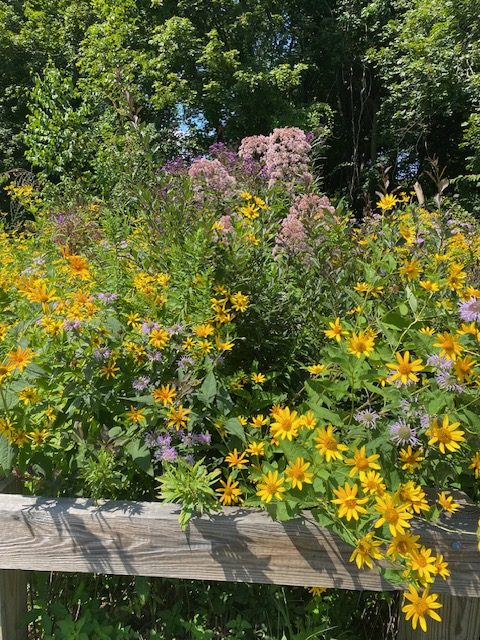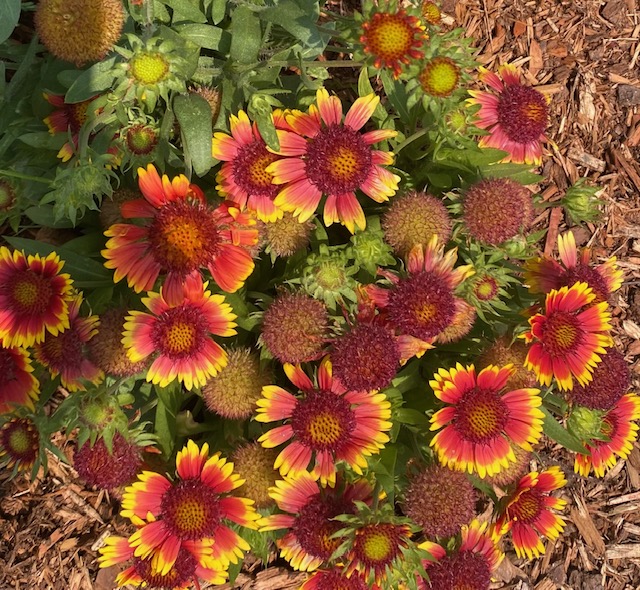
This beautiful little Indian Blanket Flower (Gaillardia arista Arizona Sun) above practically screams summer! It blooms from June through September and provides nectar for a variety of pollinators. There are several varieties along the walk just before entering the garden. Summer is a time of great activity here. There are hundreds of flowers in bloom and a host of pollinators visiting them, so there is a soft buzz – almost a vibration in the air. As ornamental grasses and slender stems sway in the wind they add to the sense of activity and animation. To the left of the garden entrance is a tall burst of swaying yellow flowers with the off-putting name of sneezeweed (Helenium autumnale). It’s name comes from its historical use as a snuff not from any allergenic properties. Sneezeweed can grow in sun or partial shade and is attractive to many native bees and host to several specialist bees. Home gardeners may appreciate its height of 4-5 feet at the back of their garden.
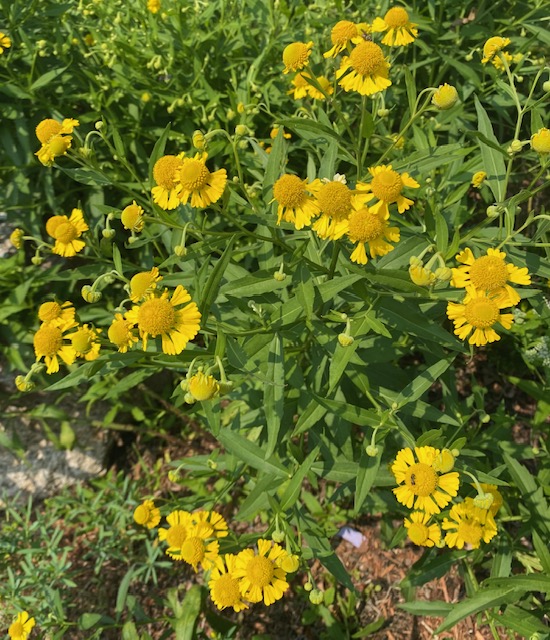
Next to the sneezeweed is Common Boneset (Eupatorium perfoliatum) – another large plant- with flat topped white clusters. Boneset can grow to 6 feet tall, and attract a variety of bees, including various solitary ones to its nectar-filled umbrellas of flowers. Flies, beetles, moths and wasps are also visitors, and it is a host plant for 42 butterflies and moths. It is prolific into the fall. Boneset is truly a pollinator magnet! Native Americans used the plant medicinally to treat fevers, and the settlers to treat conditions related to bones – not recommended! Home gardeners will need sufficient space and a consistent water source until boneset is established, but this plant is worth it!
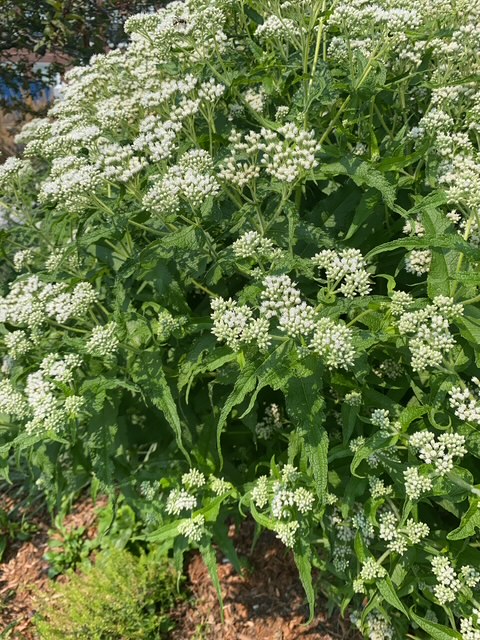
Another large plant provides a backdrop for the interior of the garden. Joe-Pye Weed (Eupatorium dubium ‘Baby Joe’) attracts numerous pollinators, providing a vital nectar source during periods when most other flowers have ceased blooming. Because each floret is so slim, it can be difficult to see that many small flowers are packed together to create each “fluffy” head. It grows into individual clumps that may reach 4 feet and become top-heavy but can be staked or pruned earlier in the season to produce a smaller plant. Various butterflies, hummingbirds and honeybees are attracted to it, and honey from bees that forage Joe Pye is fruity with a lovely orange color. Joe- Pye Weed prefers partial shade and moist soil but can adapt to sandier soils. It is deer resistant. Native Americans used the plant to induce sweating to treat fevers. The name itself is linked to a legend about a Native American healer who used it to cure settlers of typhus and other illnesses. Next to Joe-Pye Weed is a lovely hydrangea that was part of an earlier planting. It is an excellent example of how existing gardening elements can be used while introducing pollinator friendly plants
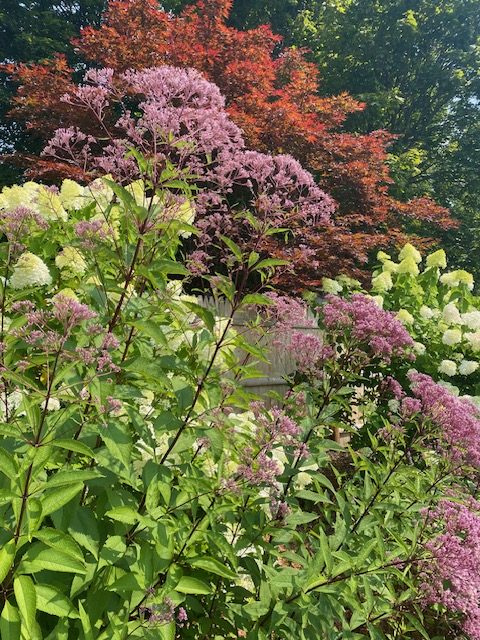
Colorful Bee Balm is scattered through the main garden. One of the most intense in color is Raspberry Wine (Monarda didyma) with its deep reddish tones. This particular Bee Balm is one of the cultivars most resistant to powdery mildew – an important quality to check before purchasing one. It can be planted in full sun to partial shade. Hummingbird, butterflies and bees frequent this aromatic member of the mint family. It is nectar-rich, and its tubular shaped flowers make it easy for bees with longer tongues to access the nectar. Deadheading will encourage blooms on side shoots.
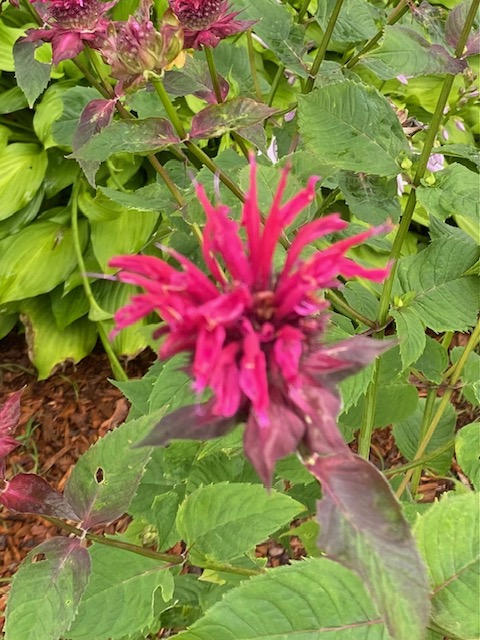
There are Monarda of different sizes and shades that will give the home gardener many choices for their native plant displays. A smaller Bee Balm with a more clustered growth pattern is Pink Lace – found several places in the garden. Although long-lived, plants will benefit from dividing every 3 years in early spring to prevent the center from dying out. Monarda has a long history of medicinal use with Native American tribes. It was used in poultices for skin infections and as a tisane to alleviate coughs and congestion. Monarda was part of a blend of plants which were used to make the famous “Liberty Tea” used by early settlers as a substitute for traditional tea – particularly after the Boston Tea party. Another common name is Oswego tea.
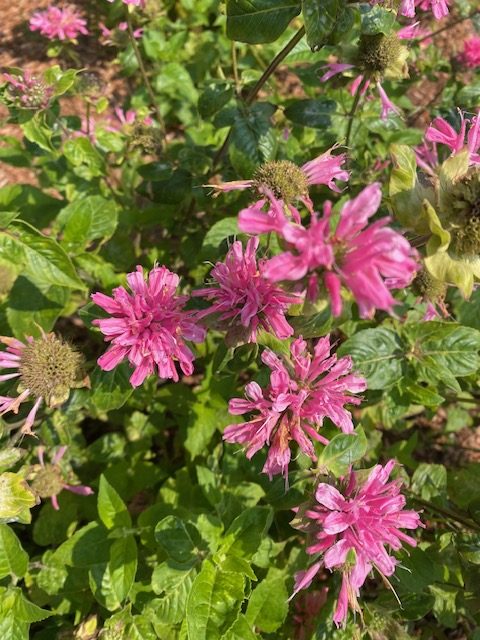
A good companion plant for Bee Balm is Anise Hyssop (Agastache foeniculm) which is also in the mint family – note the characteristic square stem. Hyssop has a minty, licorice aroma with long, tubular flowers which provide easy access to nectar for bees and butterflies. It is known as the “pollinator magnet” because of its abundance of pollen and nectar. Thriving in full sun to partial shade, it will do well in a variety of soils, particularly those with good drainage. Hyssop will readily reseed and fill in gaps in the garden. Its medicinal use in Native American culture was similar to Bee Balm, but it was also burned as an incense to calm the senses. The Cheyenne used Anise Hssop in sweat lodges.
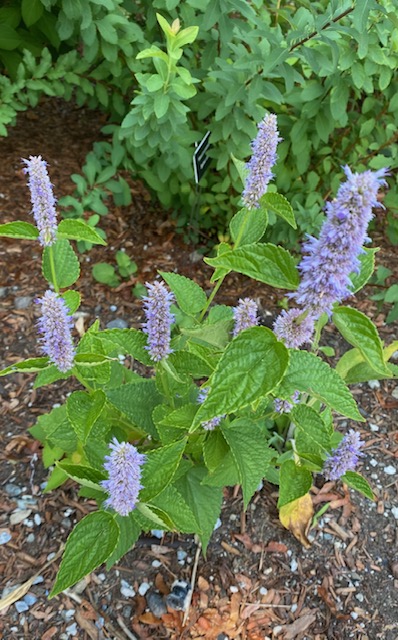
Gardeners know they cannot depend on cultivars having the same characteristics as the parent plant. Emphasis on size or color in the selection process may produce an attractive plant, but one that is no longer available to pollinators. Sometimes, however, cultivars keep beneficial characteristics of the parent plant and add good new ones. Obedience Plant (Physostegia virginiana) is known for its beautiful tubular flowers that resemble a snapdragon and its highly aggressive spreading habit. A new cultivar “Miss Manners” has the best of the parent’s characteristics – beautiful flowers and hardiness – but a much less aggressive, “mannerly” growth pattern. This plant requires 6-8 hours of sunlight daily and grows well in various soil types. It is generally not affected by deer and attracts bees, butterflies, and hummingbirds. Obedience Plant gets its name because the flower stalks will temporarily “hold” any position they are given.
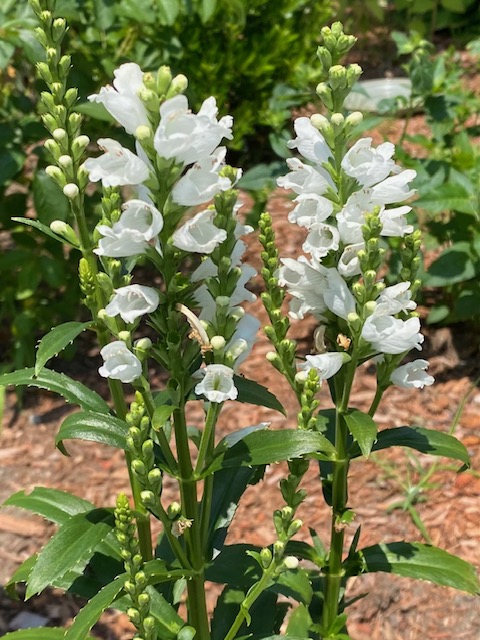
Across from Miss Manners in the outer bed are a number of decorative bunchgrasses. Little Bluestem clumps (Schizachyrrium scoparium) sway gently with any hint of breeze. It is fine-textured, forming dense mounds which may reach 5 feet. Blue-green stems change to mahogany-red in the fall and can persist through the winter. The seed heads are of value to small birds. Little Bluestem is tolerant of a wide range of soils but may reseed too readily for some smaller gardens. It is a host plant for several butterflies including the Indian Skipper.
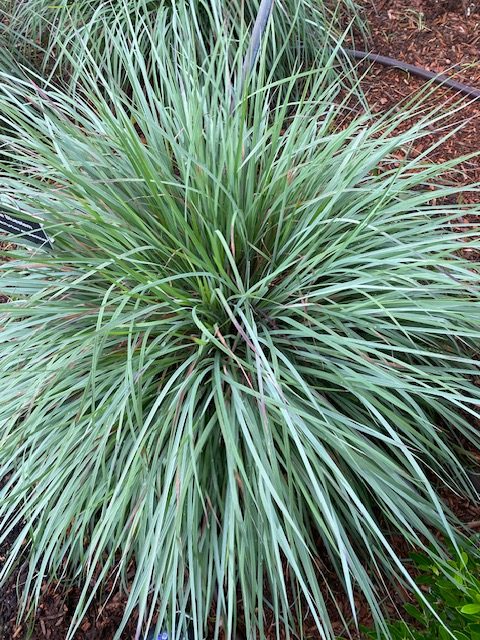
Next to Little Bluestem is one of the stars of the garden Clustered Mountain Mint (Pycnanthemum muticum). This plant is electric with pollinator activity! The leaves are a soft, soothing greenish gray and the silver bracts add visual appeal even before whitish flowers appear. Flowers are fairly small and inconspicuous to the human eye, but highly attractive to a diverse set of pollinators including bees, wasps, moths and butterflies such as various Hairstreaks and Monarchs. Mountain Mint will grow in full sun or partial shade, preferring moist soil. Once established it is a fairly low maintenance plant, generally avoided by rabbits and deer. Native Americans brewed tea from the leaves to treat a variety of ailments and used the strongly scented leaves to repel insects.
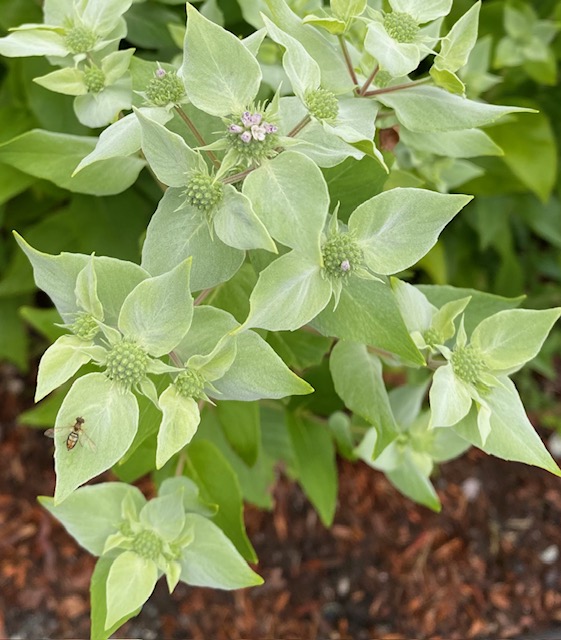
As you leave the garden, stop on the Whittier Court side and admire the beautiful little flowers of a lavender- blue Cranesbill (Geranium Rozanne) which have already been in bloom for months. Rozanne is a cultivar discovered in Somerset England with the best characteristics of its parent and awards winning new features. It is robust and vigorous with one of the longest flowering period of all hardy geraniums. Rozanne grows in sun to partial shade and can quickly create an attractive ground cover. It is particularly attractive to bees and bumblebees, providing nectar-rich flowers over an extended bloom period. It is deer and rabbit resistant.
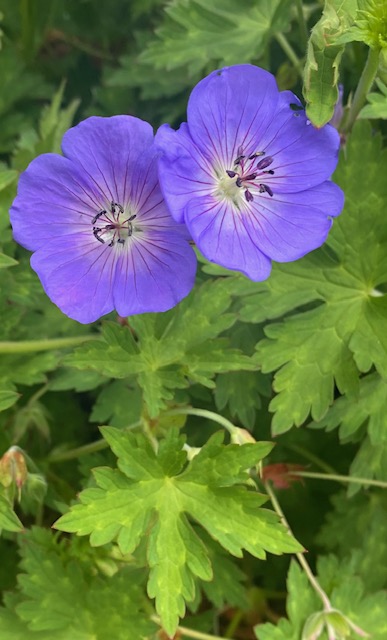
To extend your tour after leaving the garden, turn left towards the Playstead parking lot and turn onto the trail that loops at the back of the lot. The town has lined it with wildflowers. See how many you can now identify after visiting the Intergenerational Garden!
